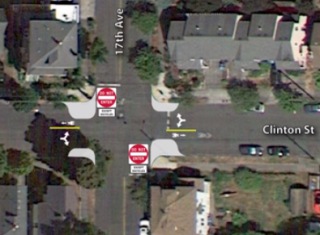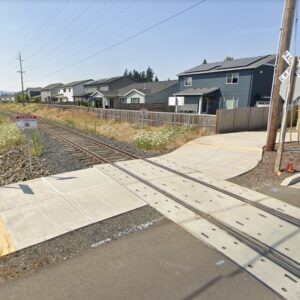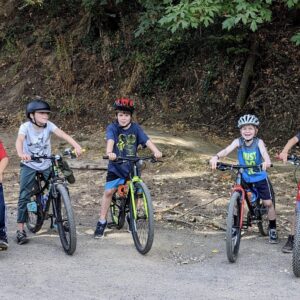
presentation by PSU Traffic and Transportation Class
participant Taylor Gibson.
One of Portland’s most remarkable public-policy traditions takes place tonight: A handpicked handful of citizen transportation wonks will present their ideas for how to improve the local streets to a panel of city leaders.
Among the concepts to be presented in the Portland Building tonight: a plan that would dramatically reduce “cut-through” traffic on Clinton Street by adding traffic diverters at 17th, 27th and 37th Avenues; and a proposal for a regionwide, multi-jurisdiction mobile app to let people report simple road problems like clogged grates or loose leaves.
Earnest, freewheeling and vaguely American Idol-like, these presentations are the final projects in an annual 10-week course designed to teach citizens “how to get things done in your neighborhood” by way of learning Portland’s transportational history, politics and tactics. The city-sponsored class, active since 1991, is free to selected Portlanders who apply as neighborhood advocates; it seems as if every important person in the local transportation world has either spoken at the class over the years or been one of its 1,000 graduates to date.
In addition to the lectures by current and retired officials, students complete one major project for the class: a live presentation of their solution to a local transportation problem of their choosing. Of these, six have been chosen this year by class leader Rick Gustafson to present to a panel including Portland Bureau of Transportation Director Leah Treat; Chris Warner, chief of staff to Transportation Commissioner Steve Novick; and Chris Smith, citizen advocate and member of the Portland Planning and Sustainability Commission.
Last month, Novick crashed the class in order to hear the annual slide presentation from former Vancouver BC city councilor Gordon Price and ask how to help freight and active transportation get along. He might attend tonight, too.
We’ve been lucky enough to get peeks at a couple of the presentations from the class. One of them comes from Taylor Gibson. He has studied the excessive volume of auto cut-through traffic on SE Clinton Street and he is proposing a several changes designed to fix the problem. Check out a video version of his presentation below…
Another presentation selected for tonight’s event comes from Scott Kocher. Scott is passionate about fixing the seemingly minor annoyances that plague our streets — things like cracks, misplaced curbs, wheel-grabbing storm drain grates, and so on. He wants to made a regional, cross-jurisdictional mobile reporting tool that citizens can use to flag issues and make sure they are handled by the proper authorities. Check out his presentation below for a teaser…
Tonight’s six presentations are in the second floor auditorium in the Portland Building, 1120 SW 5th Avenue, from 6:30 pm to 8:30 pm. To learn more about the class, you can read this short essay from one of the people who took it when I did — then went on to create a pilot program that anticipated the city’s “Street Seats” campaign.






Thanks for reading.
BikePortland has served this community with independent community journalism since 2005. We rely on subscriptions from readers like you to survive. Your financial support is vital in keeping this valuable resource alive and well.
Please subscribe today to strengthen and expand our work.
You meant 6:30 pm, hopefully?
Scott Kocher’s slide #3 is one of the clearest arguments I’ve seen for better street safety. I’m no expert, but I follow a lot of urbanist, bike, and transpo blogs, and I don’t think I’ve ever seen this particular data capture: injuries per billion miles traveled, in each mode, over 30+ years. The steady decline in automobile fatality rates is certainly owing to safer cars and better-engineered roads. Hard not to infer that the flatness–even the uptick–of bike injuries and fatalities in the last ten or twelve years is owing to those same safe cocoons of steel rolling along safely on roads engineered for speed.
That’s a great proposal for Clinton Street; it’s one that should be implemented, not just there, but on many of our other bicycle boulevards as well, such as Going Street, that also experience cut-through traffic because they provide a free-flowing alternative to parallel arterials.
Could you describe the location and problems on the Going Greenway? NGs have defined targets, speeds near 20 mph and under 1,000 vehicles per day, and I think Going is achieving these goals.
SE Clinton on the other hand has not been treated to the Neighborhood Greenway standard yet.
I use Going 2x a day during typical commute hours between NE 42 and Vancouver. The only consistent problem I encounter is during the ride home around 5pm. Eastbound cars on Prescott turn north on 30th, 31st, and 32nd to go east on Going to make a left (North) on NE 33rd. This is no doubt in response to the congestion at the NE 33rd/Prescott intersection. Once an eastbound vehicle on Prescott waits to turn left on 33rd, no one behind them can proceed (well a bicycle sure can, hint hint) so the line gets pretty backed up.
I don’t care that I’m sharing the road with cars here. It’s just that in this case they’re running the stop sign to turn onto Going leading to people on Going to take evasive maneuvers. Then they tail gate or speed to get to 33rd where they inevitably make another high risk turn. In this case, legal driving would still result in a net gain, but most of these drivers are going for broke.
Going’s biggest problem right now is the pavement.
The diverters are not located very well and will signifcantly increase the amount of cut through traffic along other streets as stated, those streets are even more residential than Clinton. There will likely also be increased traffic coming to these streets already due to the added storm water planters along division. This would only shift the traffic from a bike street to a more residential street. If you then continue to add diverters everywhere, then powell and division would need to expand. A signifcant amount of cut through also uses 26th and 21st, not to mention both which are used heavily by cyclists as well. Instead of just diverting traffic you need to take the overall volumne into account. This plan might look great for cyclists who just ride down Clinton street but doesn’t show any consideration for those who live between 12th to Chavez and Division to Powell besides those directly next to the diverter (in whihc hopefully they cycle too).
No, drivers will not divert to “more residential” streets, unless they are content with stopping at stop signs every other block or frequently having to reroute because of discontinuous street grids.
The reason why bike boulevards like Clinton can be popular cut-throughs is that are fairly continuous and because the stop signs have been turned to face the cross streets, allowing a route that is largely free of traffic control devices from 26th to 39th (with the four-way stop at 34th the exception).
They will have additional stop signs but multiple streets through here are continuous as demonstrated in the presentation itself. Many drivers will still rather spread out among the three or so continuous streets hitting the stop signs about every other block versus the incredibly slow traffic on powell or division during heavy rush hour. Heck its incredibly quicker for me to hit those stop signs getting up to chavez from 26th along any of these alternates than waiting at the stoplight at 26th/powell to take powell up and get caught in that cluster if i happen to be driving around my neighborhood during rush hour. Division or powell need to be increased if you are reducing traffic elsewhere. Its obvious why clinton is the popular cut through for vehicles, its the same reason it is for cyclists (however cyclists dont bother with the stop signs anyhow but thats another story). The streets that are attractive to motorists align in many regards to those attractive to cyclists with direct route and reduced stops at the top of the list, they each just want their own street in which would be awesome but you cant reduce the overall volume of traffic flow – whether you want to plan for it or not, it will divert elsewhere. There is a good chunk of city beyond chavez and the majority of those use motor vehicles to get in to work.
Agreed. Auto traffic on Division is being drastically curtailed and this is the reason for traffic shifting to Clinton. I predicted this series of events last year as the plans for bioswales and other traffic lane reductions were begun on close-in Division. The cars are NOT going away. If the city squeeqes traffic off of Division, where are drivers supposed to go?
They’ll find alternate routes, or the auto traffic will decrease and people will find alternatives. As they do in almost every single situation were roads aren’t “freely” given to automotive priority.
In this case, the vast majority of those trips will divert and a significant number can be eliminated. People will do that once they realize the impact and time it takes to drive the arterials in times that aren’t ideal to drive in.
In the end, divert off of Clinton, let it continue to be a clear and safer route. These changes should be added ASAP. I guess we could be *nice* for the immediate present because of the construction and wait until Division is at least fixed up. But that means over a year still of dangerous driving behavior and close calls – or worse one of those drivers kills a child, mother, father or someone else while speeding down Clinton to bypass Division. Eliminating at least one of these as a viable route, which is not intended as a viable route, is of huge importance to safety and the livability of the neighborhood.
What “alternate routes” are you thinking auto traffic will take? Powell is clogged, Division is a disaster… there are NO alternate routes westbound in the morning (the traffic at that time of day is coming from the East). As much as we might wish, cars aren’t magically going to go away. Those drivers (there are people in those cars) have to get to work somehow and public transport (aka buses) will be slowed on the arterials in the same way cars are.
The obvious solution is to decrease the auto-traffic through the area.
…then, all problems are solved. Priority should be to those in the neighborhood, then to the modes hitting the neighborhood with the least impact. As for the other roads that the traffic would spill off on, almost every side road besides Clinton provides no clear route to any other arterial, which would provide no real alternative except for cars to stay where they are truly intended for arterial travel – the arterials of Division and Powell (more Powell than Division).
Thats a nice looking plan. I live in the area and to me that would be an improvement.
Cut-through traffic on Clinton has been heavy the last few months, thanks to the multitude of construction projects on Division. These diverters can’t come soon enough.
Question: won’t there also be a diverter at 12th Avenue, preventing automobile entry to Clinton at the beginning of the street? The Portland-Milkwaukie Light Rail station plan actually shows one there, so I was surprised by its absence when they reopened the 11th/12th/Milwaukie railroad crossings in August.
The Clinton SAP currently posted on the PMLR site shows a bike box westbound on Clinton, but no diverter.
Hmm. They must have edited it out of the SAP then. It was in there before they started the closure last summer.
It may still be added. A LOT of that construction and construction area is still in heavy flux. I’m not sure myself, but it still might pop up. 🙂
I walk, bike and drive along this section of Clinton, and the parallel sections of Division and Powell, and I’m not convinced we need auto diverters for the full length of Clinton. As @GlowBoy pointed out, there’s so much construction on Division now that the amount of traffic on Clinton is likely above normal. Let’s wait and see what Division is like after the streetscape project is completed and we start to see what impacts the land use changes in the neighborhood are having on transportation and route choices before we make changes to Clinton.
I have to agree- As a business owner on 25th and Clinton who has ridden on this stretch 1000s of times over the past 10 years, it would probably do us some good to wait for all the ‘dust to settle’ a bit on Division, (as well as for the unknown impact of the upcoming 20s bikeway), and then look for a long-term solution for controlling/diverting the excess traffic on Clinton, which WILL be needed in the future, for sure.
As a Board member for the Division/Clinton Business Association, I’d would be more than happy to help get area businesses behind these great bike-related ideas and solutions for our neighborhood- I commend Scott for his ideas!
Wait, we need to wait for the 20s bikeway to be installed, which will probably take 5 years if it’s anything like the 50s bikeway, then gauge its impact (an additional 1-2 years), THEN we can start talking about possibly planning to someday do something about the truly unacceptable level of auto diversion on Clinton? That sounds like a far too long timeline to me.
Alex-
As a daily bicyclist, I’m TOTALLY for all proposed changes Scott listed, as well as the discussion of other options for controlling the traffic– The unfortunate thing is it’s probably going to be next to impossible to get the City to plan, fund, and pay for installation of 3 diverters (which cost about $5-20K each I’m told) on a street that they’re already spending a lot of effort, time, and resources into (including the 20s project, light rail, and the whole street-scape/construction/apartments on Division along that route, etc)- all of which will alter/change traffic flows for both bike and car in the Division/Clinton area…
Maybe an angle that could have success politically would be to say, “Hey, the Division Streetscape changes are great on Division but having unacceptable negative impacts on Clinton. Can we have a tiny bit of extra budget to fix these final things?” This would of course have to be once the Division Streetscape things are done. I don’t think waiting for the 20’s bikeway is necessary. I can’t imagine that they’re planning to do much that would impact motor vehicle diversion on Clinton either way.
I’m glad that some higher-ranking officials will see the Clinton presentation (because more diverters on Clinton are a dire need) but I don’t know why it required someone in a transportation activism class to bring this matter to light? Shouldn’t PBOT already be aware of the ever-climbing ADTs on Clinton and working on a solution?
PBOT can’t afford to look for problems. Users need to call 823-SAFE and report them. Also, Clinton has not had Neighborhood Greenway analysis or treatment. Hopefully any future funding for retrofits will look more closely at Clinton.
Do people in cars, who routinely speed, use cell phones, and break all kinds of other traffic laws, really obey those diverters consistently? I seem to recall a case not long ago with an ice cream truck driver who repeatedly drove around a diverted until he was confronted (and captured on video). Having said that, I still think the diverters are a good idea. They establish a “norm” that many people will obey eventually and usually.
Only very infrequently do I see drivers cutting through the diverters on either Clinton or Harrison/Lincoln, which I ride regularly.
Same. Drivers seem to respect this law, at least.
Someones a little prejudice and bitter. I assume you stop at all stop signs, don’t ride on the sidewalk downtown, stop for pedestrians in unmarked/marked crosswalks, and obey all other vehicular laws while on your bicycle (yes your bicycle is a vehicle)? I hope you do or you aren’t any better and you are assuming everyone person in a car is a jackwagon just as they would assume you represent every jackwagon cyclist ignoring all traffic/safety laws.
Sho, it sounds like you maybe assume nobody does all these things while biking. To give a counterexample – I am aware of all these laws, and I obey them as much as I possibly can (e.g. I have noticed myself running a stop sign very rarely just because I didn’t see it but would have made a full, complete stop if it ).
I think the percentage of people who obey all the laws as much as they can is pretty similar whether they are biking or driving – very low. We probably need better education and enforcement as well as a little bit of clearing unnecessary rules from the books for both biking and driving.
There is actually a guy that lives right around 43rd or so with a White BMW that regularly drives down Clinton, then blows right up onto the green bike box at Cesar Chevez (literally revved the engine and continued to pull up until he was almost touching my bike one day), then continues through the Green Like eastward instead of turning off. The day he pulled up behind me he did this in SPITE of the fact there was oncoming traffic, he just forced them over. As I started my left hand turn onto the north bound bike boulevard with arm fully extended he punched it and flew around me.
I followed the car since I realized he only drove a few blocks up and had to stop (almost hitting another car or pedestrian, I couldn’t exactly tell). He then parked in front of a house. I have the tag, it is from Idaho, and have reported the driver. The subsequent weeks I found – via also reporting this on twitter – that several other cyclists had seen the same behavior from this guy.
I also know exactly what he looks like. Because I told him he had just broke about a half dozen laws and endangered people. He’d retorted with “why don’t you be a man and come up here and talk about it…” pointing to the yard in which he stood now (I was in the street). I stated I wasn’t’ interested in a physical confrontation and just wished he’d “respect others”…
Hopefully more of that behavior doesn’t continue on Clinton Street.
The solution to these diverters being ineffective for some overly aggressive and entitled drivers like this…
REAL BOLLARDS -> As I noted here: http://transitsleuth.com/2013/11/02/multnomah-street-illegal-parking-and-street-vandelism-who-to-call/
Real Bollards WILL fix the parking & diverter scofflaws. It’s easy, they’re not very expensive and they dramatically increase the safety of the streets.
I ride through the two diverters on Ankeney every day and see cars drive over them very rarely. Once or twice a year. The diverters at 33rd is impassible by cars. It’s several feet wide and full of tall plants.
The cut throughs continue further up Clinton as well. In the morning, drivers going down the hill north on 50th see the clogged intersection at Division and bail off onto Clinton westbound. They are going at a good rate of speed down the hill and cut the corner onto Clinton. I’m going east in the morning and you really have to watch as you get to 50th on Clinton, it’s not uncommon to suddenly meet a car in your lane.
The reward for cutting through is a stop free ride to Cesar Chavez. If you were heading north or west, it’s an irresistably better way than Division or 50th to Hawthorne.
And speaking of cut throughs, how’s the new 20mph speed limit doing? Any hope of enforcement? ?? ??? Anywhere???
That intersection is notoriously difficult to cross with heavy traffic and tricky sightlines causing issues for cyclists who are traveling east-west on Clinton. The Woodward/52nd offset intersection isn’t much better.
At the very LEAST, PBOT should install a median refuge island treatment (think NE 15th at Going) where cyclists and pedestrians can cross one lane of traffic at a time, while also having the ancillary benefit of preventing cut-through traffic except for drivers turning right from 50th.
Just correcting myself, the median at 15th and Going doesn’t provide a refuge. This setup is fine, as there may not be enough roadway width available at the 50th/Clinton intersection (due to curb extensions) to have median refuge islands.
Yeah, the 15th street bollards work perfectly. They’re not even super hard core like the one’s I’d LOVE to see. 😉
Greenway diverter scofflaws going thru do not enter signs like the ice cream truck are rampant. Roughly 50 per hour at rush hour at this one:
http://www.youtube.com/watch?v=F_wtD39dN4E
Mostly locals who want to shortcut and get used to doing it. City’s response? A few hours of ticketing. Won’t change much except give a few drivers a bad day. I don’t have the answer though.
Another bollard at the top of the double yellow line, and a set of those tire-shredders they put on the exits of pay parking lots to keep people from sneaking in.
I’ve seen the same behavior at NW Marshall and 10th. This was before the new curb when PBOT only had a temporary sign. Without an actual center curb, it seems people who drive aren’t necessarily diverted despite obvious signage.
One sort of awesome thing that has happened recently is on NW 19th and Johnson. A construction site has made a one way for cars, in the process essentially making a diverter. This has made Johnson actually better for bikers. I’m hoping the construction will take a long time.